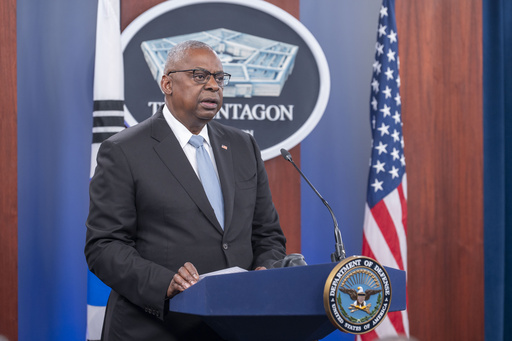
WASHINGTON — Defense Secretary Lloyd Austin has announced the deployment of additional bomber aircraft and Navy warships to the Middle East, aiming to strengthen the U.S. military presence in the region as an aircraft carrier and its accompanying vessels prepare for departure, according to multiple U.S. officials on Friday.
Austin has ordered a number of B-52 Stratofortress bombers, along with tanker aircraft and Navy destroyers, to be sent to the Middle East. This decision was made amid ongoing conflicts involving Israel, Hamas in Gaza, and Hezbollah in Lebanon, all while calls for a cease-fire continue. The U.S. has consistently reaffirmed its commitment to defending Israel and safeguarding American and allied interests in the region from threats, including Houthi missile attacks originating from Yemen, targeting vessels in the Red Sea.
The B-52, known for its long-range nuclear capabilities, has been deployed strategically as a means of warning Iran, marking this as the second month in a row that strategic U.S. bombers have been utilized to enhance defense efforts in the Middle East. Earlier, B-2 stealth bombers conducted operations against Houthi sites in Yemen.
While specific numbers regarding the aircraft and ships being deployed were not disclosed, U.S. forces in the region have recently reached as many as 43,000 personnel. A U.S. official indicated that the USS Abraham Lincoln aircraft carrier, along with three Navy destroyers in its strike group, is expected to depart the Middle East by mid-month, returning to its home base in San Diego.
Currently, the Lincoln and two of its destroyers are positioned in the Gulf of Oman, with the third destroyer operating alongside two other warships in the Red Sea. Officials noted that the departure of the Lincoln will create a temporary absence of an aircraft carrier in the Middle East. To address this shortfall, Austin plans to deploy additional Navy destroyers to the region.
These destroyers, equipped to intercept ballistic missiles, may be sourced from either the Indo-Pacific region or Europe. Overall, these changes are likely to lead to a reduction in the number of U.S. troops deployed in the region, as an aircraft carrier typically hosts around 5,000 sailors. However, the inclusion of bomber aircraft will enhance U.S. combat capabilities.
It is anticipated that the USS Harry S. Truman aircraft carrier and its three warships will be transitioning to the Mediterranean Sea, but this will occur after the Lincoln has left. At present, the Truman strike group is engaged in NATO military exercises in the North Sea.
Officials did not specify the expected duration of the carrier gap in the Middle East. Military experts have traditionally viewed the presence of an aircraft carrier strike group, equipped with various fighter jets, surveillance aircraft, and heavily armed warships, as a significant deterrent against potential threats, particularly from Iran. Additionally, the Mediterranean Sea is currently home to two destroyers and a Marine amphibious ready group comprising three vessels.
